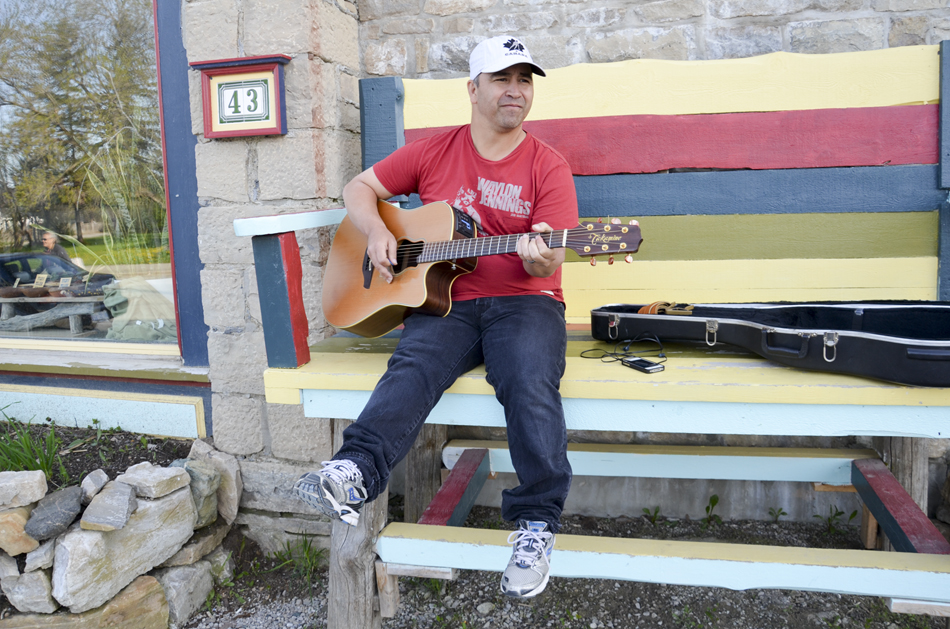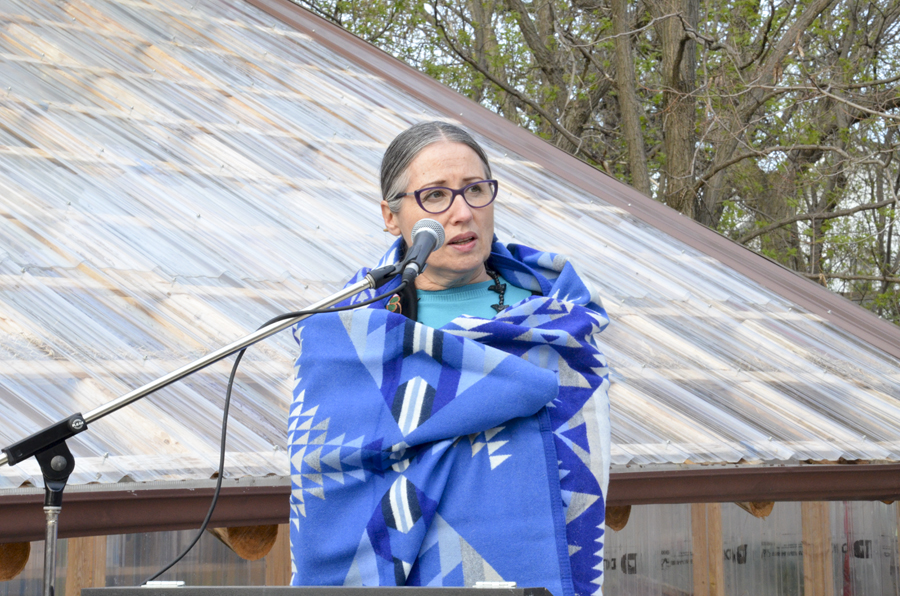Debajehmujig Storytellers hosts major national gathering
MANITOWANING—An impressive body of work has been compiled by a host of First Nations and other indigenous playwrights over the past half century and many of those artists trace their start or the prime influences in their careers in some way to Manitoulin Island’s shores, the Odawa, Ojibwe and Potawatamie Nations of the Three Fires Confederacy and Wikwemikong’s own Debajehmujig Theatre.
Over the course of these past few weeks actors, students, executive directors, artistic directors and producers have gathered at the Larry E. Lewis Creation Centre in Manitowaning to deeply explore that body of work and to create and develop new works and themes and to brainstorm the means to take creative control of their nations’ stories as the culmination of a three-year project of the National Arts Centre (NAC) and the Indigenous Performing Arts Alliance (IPAA).
On the evening of Thursday, May 14, a feast and gathering was held on the Debajehmujig grounds to celebrate the accomplishments over the past week of ‘The Study’ and to set the stage for the penultimate culmination of the project, aptly entitled ‘The Repast.’
Debaj Artistic Director Joe Osawabine welcomed the elite of Canadian indigenous theatre first with a traditional Ojibwe introduction and then in English. “It is my extreme pleasure to welcome you here this evening to the Debajehmujig Creation Centre and to the opening of ‘The Repast’,” he said, before introducing community elder and Debajehmujig board member Jeanette Corbiere Lavall to lead the group in an opening prayer.
NAC elder Annie St. George and her husband Robert took to the podium to deliver an inspirational speech. “This is a new era we are going into,” she said, noting that it was largely up to those present to rebuild much of the national identity and cultural awareness of their nations. “The way it was, we were oppressed, we were brought down,” said Ms. St. George. “Now is the time we will take a stand, through these young artists, they will teach the children.” Ms. St. George stressed that despite the trials to which the Anishinaabe have been put through, that they remain a generous people and that they would move forward through positive ways and means. “We will walk together as aboriginal people,” she said, using her and her husband’s own experiences as man and wife as a metaphor. “A kind woman, a kind man, we walk together…to give the young ones a better place.”
“Let’s enjoy and feast here the next few days,” said Mr. St. George following his wife’s address. “With a lot of laughter.”

The High Eagle Singers drum group of Wikwemikong were joined by the Wikwemikong Dance troop with a welcoming song and examples of traditional dance forms. The highlight of the show was the energetic performance of Paquis, the youngest dancer. “That gives you hope for the future,” quipped Mr. Osawabine.
Wikwemikoong Ogimaa (Chief) Duke Peltier provided an official welcome to the Wikwemikong Unceded Territories and suggested that the gathering would germinate many beneficial new relationships “where we can all call our stories,” he said. “It is good to see the number of gifted storytellers here.” Chief Peltier cited Drew Hayden Taylor and Manitoulin’s own Herbie Barnes as outstanding examples. “They have been telling their stories for years,” he said.
Debaj executive director Ron Berti provided his own welcome to the assembly before introducing the evening’s keynote speaker, community leader, teacher, historian and storyteller Esther Osche of Whitefish River First Nation. “Currently, she is working with the provincial and federal governments on outstanding land claims,” he said, adding that Ms. Osche has dedicated her life to the stories and history of her people. Mr. Berti credited a conversation with Ms. Osche as forming a key part of the foundation of his own vision and philosophy behind Debaj’s space.
“Maybe that is what this is all about,” he said. “The primary goal, to create a space, an unencumbered space in which to create.”
Ms. Osche in her turn captured the audience’s attention, keeping them spellbound from her first words until her last. A master storyteller in her own right, Ms. Osche took those attending the feast back to the beginnings of her people, the people of the Three Fires Confederacy on the shores of the great salt sea, through the great migration to the final settlements of the Odawa, Ojibwe and Potawatamie peoples around the Great Lakes and into Oklahoma. She spoke of how marriages were once arranged by the family and how life was led in those days prior to contact.
“We do not forget our dead,” she said. “We honour them.”
Ms. Osche spoke of the stories told to her by her grandparents. “My grandfather thought I would enjoy the stories of the battles,” she said, her smile a hinting at a mischievous humour. “What I really liked were the stories my grandmother would tell. The stories of what happened when a husband was chosen that you didn’t like. Now that was interesting.”
“They think we have forgotten our history,” said Ms. Osche, “but we remember our grandfathers’ stories.”
Following Ms. Osche’s address which, along with the rest of the evening’s proceedings, was filmed by a Debaj crew, Mr. Osawabine acknowledged the support of the Indigenous Performing Arts Alliance.
“Chi-miigwetch to Cole Alvis and Brittany Ryan as well as the board of directors at IPAA for all the work they have done in supporting this initiative,” said Mr. Osawabine as he displayed the IPAA medicine bundle to which items from Debaj would be added. “Another organization without which none of this would be possible is the National Arts Centre, particularly the folks from NAC who have put in countless hours of time, energy and resources, Jill Kaylee, Clayton Baraniuk, Andy Lunny, Nathan Medd and of course, Sarah Garton Stanley.”
“These past two weeks have been filled with laughter, tears, joy, hope and inspiration,” said Mr. Osawabine. “At times this has not been an easy road to walk down. But I must say that, from a Debajehmujig perspective, this has been one of the best cross cultural collaborative experiences we have ever been involved in and incredibly brace on the part of the NAC.”
As to Ms. Stanley’s contribution, Mr. Osawabine lauded the efforts of the woman who at times was “the only white girl in the room. It would have been so easy to shut down and walk away from this at any point when trouble was brewing, but she didn’t. She couldn’t. Instead, when things got rough, she buckled down and prepared to weather the storm with us. I believe she believes just as strongly as we do that these are stories that need to be told.”
Over the course of the next two days, during the repast, a series of panel discussions took place between some of the leading lights of the industry before new works were performed. Many of those performances included the nine NAC students in attendance (along with Debaj student Jessie Wabegijig, who found himself included amongst the august assembly).
Sadly the productions from the body of indigenous work sampled, performed or read during the project were on loan from the original artists for limited distribution for the purposes of study and not public presentation—many, such as Monique Mojica’s Princess Pocahantas and the Blue Spots were taking to the stage for the first time in a decade, while others, such as Tomson Highway’s Dry Lips Ought to Move to Kapuskasing have become familiar parts of the Canadian theatre mosaic.
For more about The Study and The Repast, see next week’s Expositor for interviews with the artistic directors, actors and students and some of the discussions that took place during the project.




